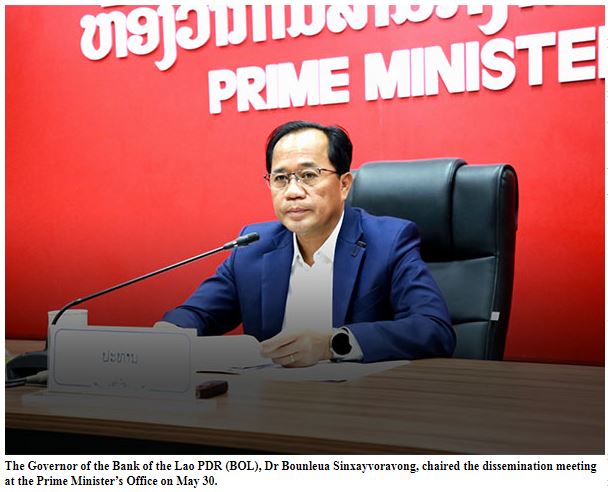Laos: Central bank disseminates scheme on credit policy for economic stimulus
The Bank of the Lao PDR (BOL) has informed key stakeholders of the objectives of its credit policy in order to stimulate economic growth as part of the implementation of a resolution of the National Assembly.
A meeting to outline the objectives of the policy was held at the Prime Minister’s Office on Tuesday, chaired by the Governor of BOL, Dr Bounleua Sinxayvoravong. The meeting was attended by ministers from line ministries, deputy governors of provinces and the mayor of Vientiane.
The overall objective of the credit policy is to stimulate economic growth in line with the implementation of resolution No 56/NA of the National Assembly, issued on July 8, 2022. This is being done under the directions of the government and the resolution of the open meeting of the BOL Party Committee to promote and provide credit for investment projects that support socio-economic development and the growth of domestic businesses.
In addition, the credit policy focuses on the production, trade and services sectors, which are crucial for replacing imports, promoting the export of domestic goods, creating jobs, maintaining macro-financial and monetary stability, and economic development for sustainable growth.
The specific objectives of the policy include creating conditions for businesses in priority sectors of the state to access sources of capital.
According to a summarised report from the BOL that was presented at the meeting, the credit policy to stimulate the economy is divided into two sub-policies – the credit policy to fill the interest hole, and the credit policy to distribute capital sources to local areas.
For instance, the credit policy to fill the interest hole will be dependent on the source of loans, through the use of capital from commercial banks, and interest subsidy. There is a state budget of 500 billion kip per year or a total of 2,500 billion kip for five years.
The interest rate is calculated based on market mechanisms and the interest subsidy rate. The rate for a short-term period of not more than one year will be 5 percent and not more than 60 percent of the interest rate of commercial banks.
For the middle-term period from one year to three years, the interest rate will be 4 percent and not more than 50 percent of the interest rate of commercial banks. Fir the long-term period from three to five years, the interest rate will be no more than 40 percent of the interest rate of commercial banks.
The credit policy to distribute funding to local areas will be dependent on the sources of loans, such as using funds of the BOL for amounts up to 1,500 billion kip for a period of not more than five years.
The funds from the central bank will be allocated to commercial banks with an interest rate of 3 percent per year, while the commercial banks will provide loans to businesses with an interest rate of 5.50 percent to 6 percent per year.
The policy’s interest subsidy is set in the kip currency (LAK). In cases of lending in foreign currency, the consideration of interest subsidy will be done in the kip currency only.
Under the credit policy to fill in the interest hole, loans will be provided to four priority sectors – agriculture-forestry sector (40 percent of the policy funding), industrial-processing sector (25 percent), services, tourism and handicrafts (25 percent), and the trade-commercial sector (10 percent).
According to the plan for the credit policy to distribute funding to local areas, Vientiane and the provinces of Savannakhet and Champassak provinces will have access to 100 billion kip each, and the provinces of Phongsaly, Luang Namtha, Oudomxay, Bokeo, Luang Prabang, Xayaboury, Huaphan, Xieng Khuang, Vientiane, Borikhamxay, Khammuan, Saravan, Xekong, Attapeu and Xaysomboun will get 80 billion kip each.
Micro, small and medium-sized enterprises and a number of large enterprises in priority sectors will be able to benefit from the credit policy to fill the interest hole.
Micro-enterprises, small and medium-sized enterprises in priority sectors that have received technical and comprehensive certification from relevant sectors of the province will be qualified to benefit from the credit policy to distribute funding to local areas.
The conditions for funding recipients stipulate that an enterprise must not have non-performing loans (NPL) and have a clear and precise business plan.
Domestic commercial banks that can take part in the project include state-invested commercial banks, joint-venture state commercial banks, and domestic private-invested banks.
BOL is currently establishing several committees to implement these sub-policies at the central and provincial levels and to create regulations, measures and principles that can be used as references for the practical implementation of the project.
Source: https://www.vientianetimes.org.la/freeContent/FreeConten2023_Central104.php


 Thailand
Thailand




